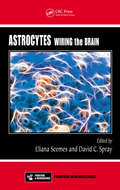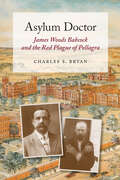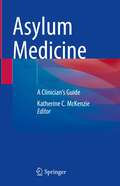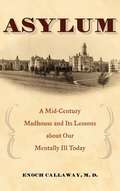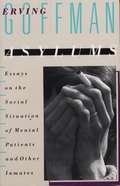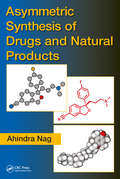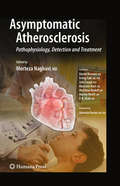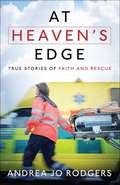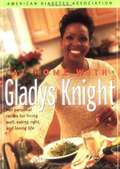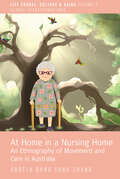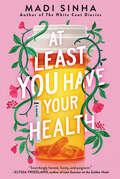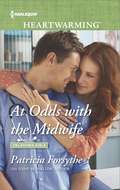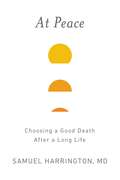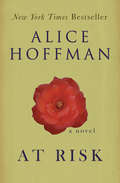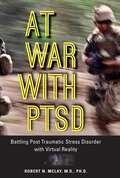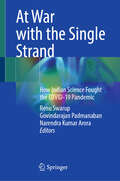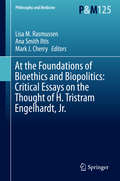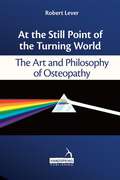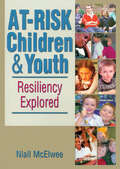- Table View
- List View
Astrocytes: Wiring the Brain (Frontiers in Neuroscience)
by David C. Spray Eliana ScemesAstrocytes play diverse roles in central nervous system (CNS) function and dysfunction, and the connections that the astrocyte makes with other cells of the brain are essential for a variety of important neural tasks. Bringing together contributions from international experts at the top of their field, Astrocytes: Wiring the Brain emphasizes cellul
Astrovirus Research: Essential Ideas, Everyday Impacts, Future Directions
by Stacey Schultz-CherryAstroviruses were first identified in the feces of children in 1975. Since then, they have been found in ~ 3 to 20% of children with diarrhea. Given that serological studies have demonstrated that up to 90% of children have been exposed to at least one strain of astrovirus by age 9, the prevalence of infection may be much higher. Supporting this are studies demonstrating that astroviruses can also be isolated in a subset of asymptomatic individuals, suggesting that a proportion of infected individuals shed the virus asymptomatically or for some time after the resolution of other symptoms of infection. Asymptomatic carriers may be a major reservoir for astroviruses in the environment and could contribute to dissemination of the virus. Astroviruses are extremely stable in the environment and can be transmitted nosocomially, directly from infected individuals and potentially animals, and through contaminated food and water. Although typically an acute disease, astrovirus infection in premature infants may be associated with the development of necrotizing enterocolitis and in new-onset celiac disease in children. Immunocompromised children are even more susceptible often developing persistent infections that lead to wasting or even systemic infections associated with fatal encephalitis. In spite of its importance, little is known about astrovirus pathogenesis, molecular biology, epidemiology, or cell biology. The goal of this book is to provide the latest and most up-to-date information on this medically important and rapidly evolving group of viruses. It will include sections on the history of astroviruses and their disease in humans; information on viral replication and immune responses; new information on how astroviruses induce disease including the expression of a viral enterotoxin regulating intestinal epithelial cell tight junctions, the isolation and identification of new astrovirus genotypes in mammals including humans, and astroviruses of veterinary importance. Finally, the book will also introduce the complexity of astrovirus epidemiology and potential as an important new zoonotic disease, and its role in food-borne disease. This will be the first book of its kind and will be of great interest to microbiologists, virologists, infectious disease specialists, immunologists, pediatricians, public health and food safety experts, veterinarians, poultry industry specialists, and researchers and clinicians interested in enteritis.
Asylum Doctor: James Woods Babcock and the Red Plague of Pellagra
by Charles S. BryanThis biography of an early twentieth-century South Carolina doctor sheds light on his pioneering work with the mentally ill to combat a public health scourge.Thousands of Americans died of pellagra before the cause—vitamin B3 deficiency—was identified. Credit for solving the mystery is usually given to Dr. Joseph Goldberger of the US Public Health Service. But in Asylum Doctor, Charles S. Bryan demonstrates that a coalition of American asylum superintendents, local health officials, and practicing physicians set the stage for Golberger’s historic work—chief among them was Dr. James Woods Babcock.As superintendent of the South Carolina State Hospital for the Insane from 1891 to 1914, Babcock sounded the alarm against pellagra. He brough out the first English-language treatise on the subject and organized the National Association for the Study of Pellagra. He did so in the face of troubled asylum governance which, coupled with Governor Cole Blease’s political intimidation and unblushing racism, eventually drove Babcock from his post. Asylum Doctor describes the plight of the mentally ill in South Carolina during an era when public asylums had devolved into convenient places to warehouse inconvenient people. It is the story of an idealistic humanitarian who faced conditions most people would find intolerable. And it is important social history for, as this book’s epigraph puts it, “in many ways the Old South died with the passing of pellagra.”
Asylum Medicine: A Clinician's Guide
by Katherine C. McKenzieAsylum medicine, a field encompassing medical forensic evaluations of asylum seekers, is an emerging discipline in healthcare. In a time of record global displacement due to human rights violations, conflict and persecution, interest in the medical and psychological evaluation of individuals subjected to torture and other ill-treatment is high. Health professionals are uniquely qualified to use their skills to make contributions to a group of vulnerable individuals fleeing danger and death in their home countries. Health professionals involved in asylum medicine perform medical and psychological forensic evaluations of asylum seekers. Their educational background prepares them to examine and describe physical and emotional scars related to trauma, and further training allows them to assess these scars in the context of persecution, describe them in a medical-legal affidavit and support these findings with testimony. Providers of asylum medicine are often involved in advocacy, as many governments become increasingly hostile to asylum seekers. Books on human rights exist, but there is no authoritative text of asylum medicine. This book presents a comprehensive overview of asylum medicine, with emphasis on the historical and legal background of asylum law, best practices for performing asylum examinations, challenges of examining detained asylum seekers, education of trainees and advocacy. Written by experts in the field, Asylum Medicine: A Clinician's Guide is a first of its kind resource for health care providers who practice asylum medicine.
Asylum: A Mid-Century Madhouse and Its Lessons about Our Mentally ill Today
by Enoch CallawayIn his witty and warm history of the facility founded in 1833, Callaway reflects not just on the events in this fortress-like place, but also how those events parallel advances and failures in the field of psychiatry itself.
Asylums: Essays on the Social Situation of Mental Patients and Other Inmates
by Erving Goffman'Asylums' is an analysis of life in "total institutions"--closed worlds like prisons, army camps, boarding schools, nursing homes and mental hospitals. It focuses on the relationship between the inmate and the institution, how the setting affects the person and how the person can deal with life on the inside.
Asymmetric Synthesis of Drugs and Natural Products
by Ahindra NagThis book focuses on different techniques of asymmetric synthesis of important compounds, such as drugs and natural products. It gives insightful information on recent asymmetric synthesis by Inorganic, Organic and Enzymatic combinations. It also emphasizes chiral compounds and design of new catalyst for synthesis of compounds.
Asymmetry as a Foundational and Functional Requirement in Human Movement: From Daily Activities to Sports Performance (SpringerBriefs in Applied Sciences and Technology)
by Filipe Manuel Clemente José Afonso Cristiana Bessa Filipe Pinto Diogo Ribeiro Beatriz Moura Tiago Rocha Marcus Vinícius Rui Canário-Lemos Rafael PeixotoThis book describes the structural and functional asymmetries in human body movement by providing cases and examples using illustrations and easy-to-understand scenarios. Specifically, it adopts an evidence-based approach to demonstrate (i) the role of structural (e.g., bone dimensions) and functional (e.g., hemispheric dominance) asymmetries in the human body; (ii) the asymmetric nature of most daily activities (e.g., gait, mastication); (iii) the benefits of asymmetry for physical performance; and (iv) the role of asymmetry in preventing injury. More than just a scientific book, it bridges the gap between theory and practice, and includes practical examples and applications. The book appeals to academics and practitioners in the fields of kinesiology, human movement, sports sciences, strength and conditioning, and physiotherapy.
Asymptomatic Atherosclerosis: Pathophysiology, Detection and Treatment (Contemporary Cardiology)
by Morteza NaghaviDespite recent advances in the diagnosis and treatment of symptomatic atherosclerosis, available traditional screening methods for early detection and treatment of asymptomatic coronary artery disease are grossly insufficient and fail to identify the majority of victims prior to the onset of a life-threatening event. In Asymptomatic Atherosclerosis: Pathophysiology, Detection and Treatment, Dr. Morteza Naghavi and leading authorities from the Society for Heart Attack Prevention and Eradication (SHAPE) present a new paradigm for the screening and primary prevention of asymptomatic atherosclerosis. The text focuses on accurate, yet underutilized, measures of subclinical atherosclerosis, notably coronary artery calcium scanning and carotid intima-media thickness measurement. The authors introduce a comprehensive approach to identifying the vulnerable patients (asymptomatic individuals at risk of a near future adverse event). Additional chapters discuss future directions towards containing the epidemic of atherosclerotic cardiovascular disease using innovative solutions such as preemptive interventional therapies (bioabsorbable stents) for stabilization of vulnerable atherosclerotic plaques, mass unconditional Polypill therapy for population-based risk reduction, and ultimately vaccination strategies to prevent the development of atherosclerosis. Up-to-date and authoritative, Asymptomatic Atherosclerosis: Pathophysiology, Detection, and Treatment is a must-have for any cardiologist or primary care physician who wishes to practice modern preventive cardiology and manage the increasing number of asymptomatic atherosclerotic patients. Outlines more accurate measures of risk (coronary artery calcium and carotid intima-media thickness) than traditional risk factors (total cholesterol, LDL cholesterol, HDL cholesterol) Presents new multipronged strategies to aid in the early detection and treatment of high risk asymptomatic patients
Asymptomatic Carotid Artery Stenosis: A Primer on Risk Stratification and Management
by Tatjana Rundek Issam D Moussa Jp MohrThis well-illustrated text reviews the current state of knowledge with regard to the various anatomic and physiologic methods available to identify asymptomatic patients who are at high risk to develop a future stroke. Asymptomatic Carotid Artery Stenosis is particularly targeted towards physicians involved in clinical decision making regarding rev
Asymptotic and Analytic Methods in Stochastic Evolutionary Symptoms
by Dmitri Koroliouk Igor SamoilenkoThis book illustrates a number of asymptotic and analytic approaches applied for the study of random evolutionary systems, and considers typical problems for specific examples. In this case, constructive mathematical models of natural processes are used, which more realistically describe the trajectories of diffusion-type processes, rather than those of the Wiener process. We examine models where particles have some free distance between two consecutive collisions. At the same time, we investigate two cases: the Markov evolutionary system, where the time during which the particle moves towards some direction is distributed exponentially with intensity parameter λ; and the semi-Markov evolutionary system, with arbitrary distribution of the switching process. Thus, the models investigated here describe the motion of particles with a finite speed and the proposed random evolutionary process with characteristics of a natural physical process: free run and finite propagation speed. In the proposed models, the number of possible directions of evolution can be finite or infinite.
At Ansha's: Life in the Spirit Mosque of a Healer in Mozambique (Medical Anthropology)
by Daria TrentiniAt Ansha's takes the reader inside the spirit mosque of a female healer in Nampula, northern Mozambique. It is here that Ansha, a Makonde spirit healer, heals the resisting ailments of her patients, discloses pieces of her story of affliction and healing, and engages the world outside her mosque. We come to know Ansha’s experiences as revolutionary and migrant, her religious trajectories, family, the healers who cured her, the spirits who possessed her, and her declining health. We follow Ansha’s shifts in her life and work in the mosque as these intersect with the visible and invisible borders of Mozambique and of its fraught history. Confronting events in her life and in the mosque between 2009 and 2016, Ansha invites us to make meaning with her, as we sit in her mosque, and engage with her family, spirits, friends, patients, and world.
At Heaven's Edge
by Andrea Jo RodgersVeteran EMT Andrea Rodgers has helped hundreds of people in their most vulnerable moments. Some of the victims faced their mortality head-on and cried out to God for help. Many experienced fleeting but life-changing connections with their first responders. Often these crises became unexpected sources of inspiration. Now Rodgers shares brief, real-life stories of heroic courage in the face of fear. In times of intense suffering, she has repeatedly witnessed signs of God's quiet intervention and healing presence. A man is resuscitated after Rodgers was able to repair a defibrillator--with her teeth! Several bystanders help rescue a young girl who is accidently buried alive in sand. Rodgers also experienced some lighthearted moments, including the time she arrived at the scene of a crime only to find herself in the middle of a mystery dinner theater. Experience the miracles, the life-and-death drama as you look at life from heaven's edge.
At Home With Gladys Knight: Her Personal Recipe for Living Well, Eating Right, and Loving Life
by Gladys Knight Abe OgdenGladys Knight shares her life and gives practical advice for coping with diabetes. Recipes are included. There is a bit of text missing or garbled, but it should not take away from the enjoyment or usefulness of this book. Written with warmth. Scan-quality embossed braille copy should be quite readable.
At Home in a Nursing Home: An Ethnography of Movement and Care in Australia (Life Course, Culture and Aging: Global Transformations #9)
by Angela Rong Yang ZhangFocusing on contemporary ideas about how aged care is provided, this book poses the question: How can people who are aged and frail live out the final phase of their lives with dignity? In seeking answers, the author examines what it means to be ‘at home’ in residential care in a novel and compassionate way. In an ethnographic study of how elderly residents can be given the right care, this book provides a new route into the bodily realities of ageing. It is a vital contribution to the search for alternative approaches to aged care provision.
At Least You Have Your Health
by Madi SinhaBehind the chic veneer of a wellness clinic lies a dangerous secret, in this compelling women's fiction novel from the author of The White Coat Diaries. Dr. Maya Rao is a gynecologist trying to balance a busy life. With three young children, a career, and a happy marriage, she should be grateful—on paper, she has it all. But after a disastrous encounter with an entitled patient, Maya is forced to walk away from the city hospital where she&’s spent her entire career. An opportunity arises when Maya crosses paths with Amelia DeGilles at a school meeting. Amelia is the owner and entrepreneur behind Eunoia Women&’s Health, a concierge wellness clinic that specializes in house calls for its clientele of wealthy women for whom no vitamin infusion or healing crystal is too expensive. All Eunoia needs is a gynecologist to join its ranks. Amid visits to her clients&’ homes, Maya comes to idolize the beautiful, successful Amelia. But Amelia&’s life isn&’t as perfect as it seems. When Amelia&’s teenaged daughter is struck with a mysterious ailment, Maya must race to uncover the reason before it&’s too late. In the process, she risks losing what&’s most important to her and bringing to light a secret of her own that she&’s been desperately trying to keep hidden.
At Odds with the Midwife
by Patricia ForsytheFrom high school crush to enemy number one Gemma has always been a rescuer. Birds with broken wings, abandoned baby raccoons...anything that needs help. But when it comes to her lifelong crush, doctor Nathan Smith, she has to curb her natural instincts. All of them. Nathan doesn't trust midwives, and he doesn't want her help. Back in town to restore the community hospital his father bankrupted, Nathan's just as determined to shut down the birthing center. How can Gemma Whitmire save her center and prove Nathan-and the other critics-wrong? And more important, how can she stop falling for him?
At Peace: Choosing a Good Death After a Long Life
by Samuel HarringtonThe authoritative, informative, and reassuring guide on end-of-life care for our aging population.Most people say they would like to die quietly at home. But overly aggressive medical advice, coupled with an unrealistic sense of invincibility or overconfidence in our health-care system, results in the majority of elderly patients misguidedly dying in institutions. Many undergo painful procedures instead of having the better and more peaceful death they deserve. AT PEACE outlines specific active and passive steps that older patients and their health-care proxies can take to ensure loved ones live their last days comfortably at home and/or in hospice when further aggressive care is inappropriate. Through Dr. Samuel Harrington's own experience with the aging and deaths of his parents and of working with patients, he describes the terminal patterns of the six most common chronic diseases; how to recognize a terminal diagnosis even when the doctor is not clear about it; how to have the hard conversation about end-of-life wishes; how to minimize painful treatments; when to seek hospice care; and how to deal with dementia and other special issues. Informed by more than thirty years of clinical practice, Dr. Harrington came to understand that the American health-care system wasn't designed to treat the aging population with care and compassion. His work as a hospice trustee and later as a hospital trustee drove his passion for helping patients make appropriate end-of-life decisions.
At Risk: A Novel
by Alice HoffmanA New York Times bestseller from the author of The Rules of Magic: In 1980s America, a family copes with their daughter&’s terrifying diagnosis. In a lovely old house near the coast of Massachusetts, the Farrells go through the routines of a typical August morning. Eight-year-old Charlie, a junior biologist and dinosaur expert, tries to collect one of his insect specimens. His sister, Amanda, a talented gymnast who at eleven years old is already saving her money to try out for the Olympics, prepares for her last meet of the summer. Ivan, their absent-minded father, is involved with his work as an astronomer. Out in the garden, his wife, Polly, wonders how she can trick her children into eating more zucchini. They are a family as unique and ordinary as any other, but their world will soon be shattered when Amanda is diagnosed with the disease that has been making headlines lately: AIDS. The new and still-mysterious ailment scares them—and their friends and neighbors as well. In an instant, everything that gave their lives meaning is ripped away, and the intimacy that once came so naturally vanishes. Too overcome with grief to turn to each other, Ivan and Polly seek solace elsewhere. Charlie is abandoned by his best friend and, for long stretches at a time, forgotten by his parents. Amanda, who holds on to her dreams so tightly, must somehow find a way to let go. Torn apart by the prospect of their loss, Polly, Ivan, and Charlie must find the courage to come back together again—for Amanda&’s sake and for their own. At Risk is an exquisite book about true sorrow and even truer devotion.
At Risk: Indian Sexual Politics and the Global AIDS Crisis (Globalization in Everyday Life)
by Gowri VijayakumarIn the mid-1990s, experts predicted that India would face the world's biggest AIDS epidemic by 2000. Though a crisis at this scale never fully materialized, global public health institutions, donors, and the Indian state initiated a massive effort to prevent it. HIV prevention programs channeled billions of dollars toward those groups designated as at-risk—sex workers and men who have sex with men. At Risk captures this unique moment in which these criminalized and marginalized groups reinvented their "at-risk" categorization and became central players in the crisis response. The AIDS crisis created a contradictory, conditional, and temporary opening for sex-worker and LGBTIQ activists to renegotiate citizenship and to make demands on the state. Working across India and Kenya, Gowri Vijayakumar provides a fine-grained account of the political struggles at the heart of the Indian AIDS response. These range from everyday articulations of sexual identity in activist organizations in Bangalore to new approaches to HIV prevention in Nairobi, where prevention strategies first introduced in India are adapted and circulate, as in the global AIDS field more broadly. Vijayakumar illuminates how the politics of gender, sexuality, and nationalism shape global crisis response. In so doing, she considers the precarious potential for social change in and after a crisis.
At War with PTSD: Battling Post Traumatic Stress Disorder with Virtual Reality
by Robert N. McLayThe Spartans called it The Trembler; recent history has seen it termed shell shock, combat fatigue, soldier’s heart, and Vietnam Syndrome. Whatever the name, post traumatic stress disorder (PTSD) has always been with us. With 20 percent of the Veterans of the wars in Afghanistan and Iraq exhibiting PTSD symptoms, the United States military has a strong interest in combating the condition. Navy psychiatrist Robert N. McLay has been at the forefront of these efforts. This is his story of using virtual reality to treat Service Members and Veterans with PTSD.As a practicing psychiatrist who works with Veterans and civilians coping with PTSD, McLay had known for years before the September 11, 2001, attacks that effective treatments for the condition were elusive. When active duty called, he met the challenge, becoming the primary investigator on PTSD treatment projects that had Service Members face the ghosts of war in a computer simulator. After using this new form of exposure therapy on the home front, McLay and his team believed they had found a promising way to work with warriors broken by combat, so in 2008 they took it to the front line in Fallujah, Iraq, with the First Marine Expeditionary Force. Several years into the project, McLay recounts openly and with bleak honesty the successes, failures, and limits of virtual reality treatment for PTSD. Filled with poignant firsthand accounts of war and its psychological aftermath, At War with PTSD explains the difficulties of using this specialized technology in the field and discusses such challenges as helping people who refuse to believe in PTSD, including those diagnosed with it. So far, the virtual reality program shows more promise than traditional therapies. And although McLay remains unsure why or how, his experiences hold out hope for those suffering from this devastating disorder.
At War with the Single Strand: How Indian Science Fought the COVID-19 Pandemic
by Govindarajan Padmanaban Renu Swarup Narendra Kumar AroraThis book provides insights into India's management of the war against COVID-19, highlighting the scientific response and featuring stories from key players. The chapters not only address the challenge but also showcase innovative solutions achieved within a short time frame. They discuss the emergence of the virus, its spread, and its hazards, exploring the scientific basis of pandemic and its biological changes, and further discussing its challenges and opportunities. The book also includes a roadmap for research and translation, featuring innovative strategies for testing, tracking, and treating the virus, as well as achievements in diagnostics. Additionally, it reflects on the global response to COVID-19 and provides strategies for future preparedness. It addresses the scientific complexities, clinical trials, and collaborative partnerships driving vaccine development and distribution in India. The book is supplemented with stories of strength and innovation from vaccine development in India as well as global collaborations. The book is relevant for scientists, researchers, policymakers, as well as national and international organizations as a resource to plan strategies for managing future health emergencies.
At the Foundations of Bioethics and Biopolitics: Critical Essays on the Thought of H. Tristram Engelhardt, Jr. (Philosophy and Medicine #125)
by Lisa M. Rasmussen Ana Iltis Mark J. CherryThis volume brings together a set of critical essays on the thought of Professor Doctor H. Tristram Engelhardt Junior, Co-Founding Editor of the Philosophy and Medicine book series. Amongst the founders of bioethics, Professor Engelhardt, Jr. looms large. Many of his books and articles have appeared in multiple languages, including Italian, Romanian, Portuguese, Spanish, and Chinese. The essays in this book focus critically on a wide swath of his work, in the process elucidating, critiquing, and/or commending the rigor and reach of his thought. This volume compasses analyses of many different aspects of Engelhardt's work, including social and political philosophy, biopolitics, the philosophy of medicine, and bioethics. It brings together internationally known scholars to assess key elements of Engelhardt's work.
At the Still Point of the Turning World: The Art and Philosophy of Osteopathy
by Robert LeverThe healing arts involve a complex range of skills which each practitioner draws together in a unique way. These skills, attitudes and perspectives complement the scientific basis underpinning each discipline to create the wisdom and artistry of any therapeutic approach.The practice of osteopathy is no exception. It involves a growing field of scientific knowledge in physics and biology that couples with an extraordinary range of human qualities to give the work depth, as well as relevance, and which can be tailored to the individual patient holistically and with compassion.At the Still Point of the Turning World examines and explores both the art and the science of osteopathy through the eyes and approach of a devoted teacher and practitioner. The true value of holism, vitalism and osteopathic principles are discussed as part of the approach that each practitioner brings to the patient/practitioner relationship.
At-Risk Children and Youth: Resiliency Explored
by Niall McElweeDiscover strategies to reinforce the strengths of the youngest members of society What assistance can be provided to a disadvantaged youngster to help them bounce back to conquer challenges while growing up? At-Risk Children and Youth analyzes the results from accumulated research on the risk and resiliency of children and youth in Ireland. Niall McElwee shines a crucial spotlight on the challenges facing children, including poor literacy and numeracy skills, poverty, distrust, and other difficult issues. Practical strategies are presented to help disadvantaged children and youth to overcome societal and self-imposed barriers for improvement. A detailed review and assessment is provided of the efficacy of Ireland’s Youth Encounter Projects. This important resource focuses on what works and what does not in youth services. At-Risk Children and Youth closely examines at-risk factors and what it specifically means to be ’at-risk’. Going further beyond the standard risk factors usually considered such as drug use or dropping-out of school, this probing text explores the full range of factors and coping and healing mechanisms. The author challenges several of the views and beliefs about risk and resiliency generally held by many in child and youth services and in society. This book is extensively referenced and includes helpful figures tables to clearly present information. Topics in At-Risk Children and Youth include: detailed breakdown of terms for risk behaviors and predictors of risk the issues of social class and social exclusion the impact of school difficulties on students, including truancy and poor academic standing building on student strengths the quality of the entirety of the school experience as a determination of success strategies for intervention a review of various literature on risk and resiliency a relational research model, including methodology and ethical issues description and functions of Youth Encounter Projects—and an assessment of their value at-risk youth perceptions of risk, in their own words results of risk studies over the past decade recommended changes in policies At-Risk Children and Youth is a valuable addition to the libraries of educators, students, and child and youth service providers everywhere.
